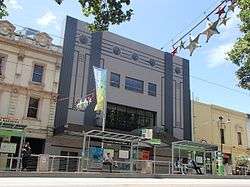Palace Theatre, Melbourne
 | |
 | |
| Former names |
Metro Nightclub Palace Theatre Metro Theatre St James Theatre Apollo Theatre Brennan's Amphitheatre |
|---|---|
| Location | 20-30 Bourke Street, Melbourne, Australia |
| Capacity | 1855 |
| Opened | 1912 |
The Palace Theatre (also known as The Palace) is an entertainment venue located in Melbourne, Australia. First built in 1912, it has undergone various alterations and renovations and changes in use from theatre to cinema to live music, but remains a recognisably historic theatre, especially the interior. Since late 2012 when it was sold, it has been subject to proposals for demolition and replacement, generating much opposition.[1]
The site of the Palace Theatre was occupied from the late 1850s until 1911 by the Excelsior Hotel. The association between hotels and theatres at the time was close, and the hotel incorporated a hall (known as the Queen’s Hall) used for vaudeville performances and other entertainment, including boxing and wrestling. In 1911 the Sydney-based architects Eaton & Bates, in association with the Melbourne architect Nahum Barnet, were commissioned to design a new theatre for the site, which opened in April 1912. It had seating on three levels and incorporated a hotel (the Pastoral Hotel) with a bar on the ground floor and bedrooms on the first floor.[2]
In 1916 the Sydney architect Henry W White designed alterations, which involved a complete refitting of the auditorium and lobby with the addition of ornate plaster decoration in a Louis Seize style. Between 1919 and c1922 the front room on the upper level was let for use as a studio to the prominent artists Arthur Streeton and Max Meldrum. [3] In 1923 the auditorium was extensively remodelled, though retaining the Louis Seize style, overlaid with 'Adamesque' decoration, and it was re-opened as 'The New Palace'.[4]
In 1940, it was again refitted, and renamed the 'St James', reopening as a cinema, then renamed again in 1951 as the 'Metro - Bourke', featuring films exclusively from MGM. A foyer for the upper circle was added at this time. The facade was substantially remodelled in an Art Deco style designed by H Vivian Taylor in 1954, while in the auditorium, the proscenium replaced, the side boxes and the balcony ends were removed to allow installation of a Cinemascope screen. [5]
In 1956, the Palace Theatre helped to inspire an enduring Olympic tradition, when a teenager named John Ian Wing wrote a letter to the organisers of the Melbourne Olympics, suggesting that the Closing Ceremony feature the athletes of all nations entering the stadium as an intermingled group. The idea was adopted, and helped to redeem the Melbourne Games' reputation as the 'Friendly Games'.[6] Wing has since written that his idea was inspired by his observation of the jumbled and spirited crowds exiting the Palace Theatre, visible from his home above a Bourke Street restaurant.[7][8]
In the early 1970s it was again used as live theatre, then briefly a cinema, then in 1980 it was purchased by the Melbourne Revival Centre as the major venue for their services, which involved theatre productions.[9]
The next sale resulted in a major refurbishment by the Melbourne architectural firm Biltmoderne was carried out in 1986 which transformed it into the Metro Nightclub.[10] In 2007 it was sold again, the name reverted to The Palace, and it became a major live music venue in Melbourne. [11]
In late 2012 it was sold to a developer who revealed plans for a major hotel and apartment development replacing the theatre in mid 2013, which generated considerable opposition, especially from Melbourne's music [12]
References
- ↑ Palace devotees step up campaign to save venue, The Age, 11 October 2013
- ↑ Assessment of Cultural Heritage Significance, Heritage Victoria, November 2013
- ↑ Assessment of Cultural Heritage Significance, Heritage Victoria, November 2013
- ↑ Heritage Appraisal, Palace Theatre, Lovell Chen, June 2013
- ↑ Heritage Appraisal, Palace Theatre, Lovell Chen, June 2013
- ↑ Button, James (11 November 2006). "Ceremony born from Wing and a prayer". The Age.
- ↑ Wing, John Ian. "History of the Olympic Closing Ceremony". Retrieved 4 December 2014.
At the time, I was living above my father's restaurant at 16 Bourke Street Melbourne, which was two doors away from St James picture theatre. It was now about 11.00pm. A few hours earlier, looking down into the street, I watched people lining up in an orderly manner waiting to go into the theatre. Now I watched them come out in one big mass, spilling out onto the road and stopping the traffic. They were smiling and laughing and even talking to strangers as if they had known each other before. Then the ‘idea’ came to me. As I was writing my letter to the chairman of the Organising Committee, I suggested that all the athletes of the world should come together for the closing ceremony, to unite and intermingle and enter the Stadium as One Nation.
- ↑ Culpepper, Chuck (23 August 2008). "His big idea had legs". Los Angeles Times.
- ↑ Heritage Appraisal, Palace Theatre, Lovell Chen, June 2013
- ↑ Assessment of Cultural Heritage Significance, Heritage Victoria, November 2013
- ↑ Palace sold for $13mill, Australian Financial Review,30 August 2012
- ↑ community.http://www.tonedeaf.com.au/news/local-news/321139/melbournes-palace-theatre-demolished-apartments.htm
External links
Coordinates: 37°48′41″S 144°58′20″E / 37.81139°S 144.97222°E